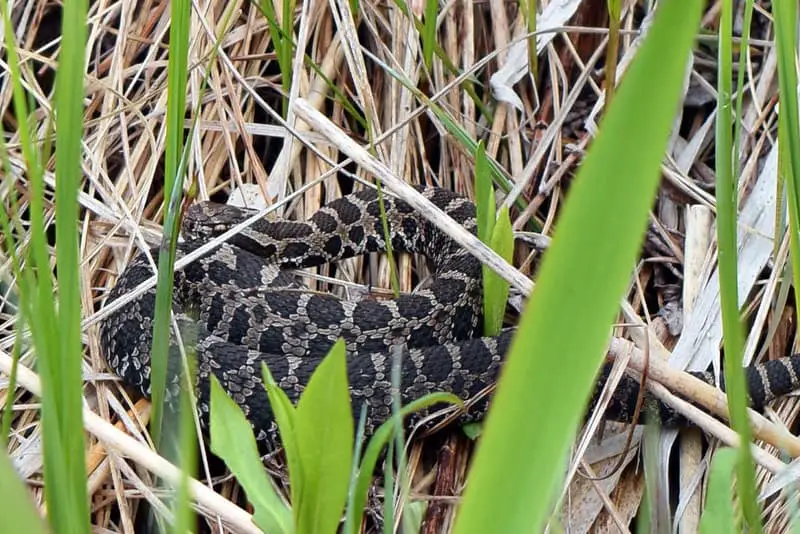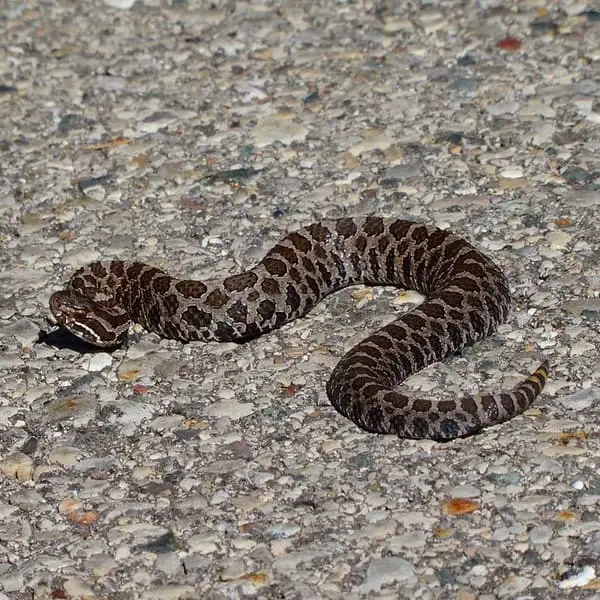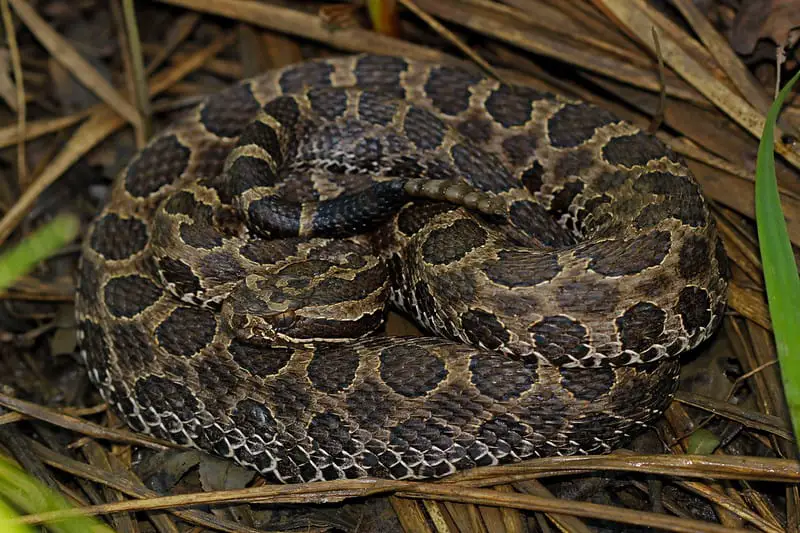The massasauga snake, Sistrurus catenatus, is a venomous snake that can be found in several U.S. states in a wide strip from Southeastern Canada to Northern Mexico. It grows up to two feet in length and has characteristic brown/black and grey/white patterns along its body that look like an iron chain.
Description
The basic coloration of the snake is mostly brown or grey with a pattern of well recognizable dark or maroon spots on the back. The dark, round spots and the grey bands make the snake almost look like an iron chain. Its specific name, Sistrurus catenatus, references to this appearance. The latin word “catenatus” means “chained”.

On the neck there is a conspicuous pair of spots and on the head a temporal band runs from the snout over the eyes to the corners of the mouth. Especially in the north of the massasagua’s range, very dark specimen with a high percentage of black color pigments are found.
Depending on the body coloration, the massasauga is sometimes confused with its close relative, thy pygmy rattlesnake that occurs in the Southeastern United States.
Size
The Massassauga reaches an average body length of about 24-30 inches (60-75 cm) and it rarely grows up to 40 inches (100 cm) long. It is the largest species of Sistrurus rattlesnakes and also larger than many Mexican rattlesnakes of the genus Crotalus.

Hunting Behavior
Like most other rattlesnakes, the massasauga usually lies in ambush waiting for clueless prey to move into striking distance. After a bite, the snake follows the wounded prey until the venom renders it immobilized and ingests it as a whole. Adults feed mostly on small rodents. The main diet of younger snakes consists of reptiles such as frogs, lizards and other small snakes such as racers.
Bite and Venom
The venom of the Massasauga corresponds in its basic composition to that of other rattlesnakes. It is hemotoxic like most viper venoms. That means that it destroys blood cells and the walls of the blood vessels. Hemotoxins mainly lead to tissue destruction, internal bleeding and swelling and are very painful. In comparison to most neurotoxins they prove less lethal. The Massassauga only produces relatively small amounts of poison, the effects usually consist of local swelling, pain and general nausea.
Even though a bite of the Massasauga is not immediately life-threatening, you should seek medical attention as soon as possible if a bite occurs.

Habitat
The massasauga can be found in various habitats. The Eastern massasauga the north lives mainly in swampy forest areas while in the Western massasauga in the Central U.S. is mostly found in grasslands. The desert massasauga, as its name suggests, can be found in the dry and arid landscapes of Texas and northerm Mexico.
Massasauga range in the USA
The range of the massasauga covers a wide strip over the central United States of America from southern Ontario, Canada, to northern Mexico. It does not occur in any coastal region. The massasauga snake can be found in the following U.S. States: Illinois, Indiana, Iowa, Michigan, Minnesota, Missouri, New York, Ohio, Pennsylvania, Wisconsin, Colorado, Kansas, Nebraska, Oklahoma, Texas, Arizona and New Mexico.
Scientific classification of Sistrurus catenatus
- Kingdom: Animalia
- Phylum: Chordata
- Class: Reptilia
- Order: Squamata
- Suborder: Serpentes
- Family: Viperidae
- Genus: Sistrurus
- Species: Sistrurus catenatus
Subspecies of Sistrurus catenatus
The Massassauga is currently split into three subspecies:
- S. c. catenatus or Eastern Massassauga occurs in the northeastern part of the distribution area. It lives mainly in swamp forests and is often darker colored than the other subspecies
- S. c. edwardsi (desert Massasauga) occurs in the southern areas of the range, including Mexico. It is smaller than the other subspecies and lives in dry areas
- S. c. tergeminus or Western Massassauga occurs in the western part of the range in the central USA and south to Texas and the Gulf of Mexico.
Other common names
black massasauga, black rattler, black snapper, gray rattlesnake (Iowa), little grey rattlesnake (Canada), muck rattler, prairie rattlesnake, spotted rattler, swamp rattler, dwarf prairie rattlesnake, eastern massasauga great adder, ground rattlesnake, Kirtland’s rattlesnake, little black rattlesnake, Michigan point rattler (Michigan), prairie massasauga, rattlesnake, small prairie rattlesnake, snapper, swamp massasauga, swamp rattlesnake, and triple-spotted rattlesnake.